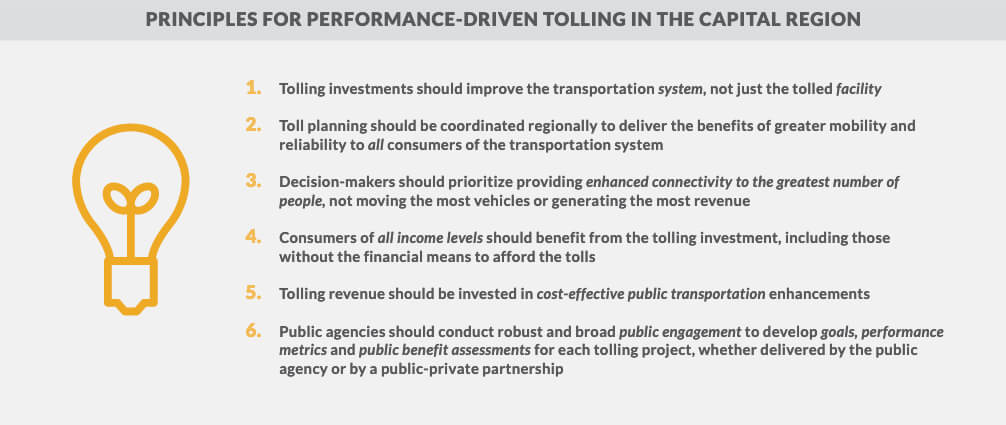Tackling The Capital Region’s Roadway Congestion: Performance-driven Tolling
Publish Date: May 2018

 Download Report »
Download Report »
The Capital Region of Baltimore, Washington, and Richmond is the third-largest regional economy in the United States, with a deep and diverse talent pool and globally leading innovation assets. However, the performance of our region’s transportation system risks holding back our potential.
Roadway congestion places a significant burden on many of our 10.2 million residents and their employers.
While congestion is a sign of robust economic activity, excessive congestion inhibits our economic performance by limiting the ability of consumers to access jobs, arrive on time for work and meetings, and efficiently access necessary services like education and healthcare. Congestion increases the cost of trips, preventing workers, businesses, universities, and entrepreneurs from taking full advantage of the Capital Region’s amenities. A well-connected Capital Region that ensures strong income and productivity growth, retains and attracts talented workers, and provides for a high-quality of life for families who live here requires that we tackle our growing congestion challenge.
The entire region faces elements of congestion, although the challenges are most acute in the Washington and Baltimore metro areas, as well as along the I-95 corridor connecting Richmond to the District of Columbia, particularly when our roadways transform into parking lots during peak morning and evening rush. Capital Region residents and employers are paying for this congestion every day. One estimate puts the annual costs of congestion for the region at more than $7 billion.1 On average, each Baltimore metro commuter loses $1,115 annually as a result of congestion and each Washington metro area commuter loses $1,834 annually—the highest cost in the nation. And without action, the region’s congestion costs are projected to grow, with estimates showing that roadway congestion will increase by more than 50 percent by 2040.
Congestion occurs when roadway capacity cannot meet demand, producing a crawling queue of vehicles. Roadway congestion is non-linear—the last vehicles entering a congested road contribute disproportionately to the delay that everyone experiences. Convincing just a small number of consumers to shift travel to transit, high-occupancy vehicles (HOV) or move the trip to non-peak periods can greatly improve speed and reliability, which translates into less congestion.
Performance-driven tolling is a tool that, when deployed correctly, allocates a fee to single occupant vehicles, which creates incentives for consumers to divert trips to non-peak periods, increase vehicle occupants, or opt for public transportation and carpooling. As a result, congestion is reduced, speeds are increased, and reliability improves. Additionally, consumers will have improved travel options available across the board. Performance-driven tolling can also more equitably levy the costs for maintenance and capacity expansion for the road.
The Capital Region is at the national forefront of using performance-driven tolling to combat roadway congestion and improve mobility and access, with expansion of this tool currently being proposed in parts of the region. In total, Maryland and Virginia have 35 toll facilities operating, under construction, or in planning stages (13 in Maryland and 22 in Virginia). However, not all facilities deploy performance-driven outcomes, which creates an inconsistent patchwork of tolled facilities oriented around different and sometimes uncoordinated goals. This patchwork approach limits the potential benefits to the consumers and our region experiences persistent congestion points where toll systems start and end.
The Capital Region has the potential to deliver a performance-driven tolling network that improves mobility and access in highway corridors including the Washington and Baltimore Beltways, I-95, and I-270, and connects these facilities to enhanced toll operations on highways such as the Intercounty County Connector and the network of tolled facilities in Northern Virginia connected by the Woodrow Wilson Bridge and a new American Legion Bridge. It is critical the region deploy a consistent and coordinated approach to create a seamless performance-driven tolling network that delivers fair and equitable benefits, including for those without the financial means to afford the tolls, regardless of where the facility is located. This is critical because every day in the Capital Region, between home and work, one in two commuters cross a county boundary and one in five cross a state boundary. Political boundaries do not define consumer’s lives in the Capital Region. A connected performance-driven tolling network must overcome jurisdictional silos to maximize benefits.
A consistent and coordinated approach will improve each consumer’s mobility and better connect the Capital Region. The Partnership, working with a wide range of stakeholders and experts, proposes the below six principles for decision-makers o deliver on the potential of performance-driven tolling in the Capital Region. As new tolling facilities are considered and implemented, and as existing tolling facilities evolve and connect, the use of these principles consistently in Maryland, Virginia, and the District will reduce congestion and deliver the improvements to the system we desperately need. The need is too great.
With growing roadway congestion holding back our region’s economic performance, the expansion of smart and well-executed performance-driven tolling projects can help transform our region’s transportation system. However, the history of tolling projects in the United States clearly shows that initial design and delivery decisions have significant impacts on the success of a region’s entire transportation system. That is why the Greater Washington Partnership is releasing clear and demonstrable principles, that should be deployed for all new tolling facilities and, where appropriate, on existing tolling facilities as changes are considered and facilities are increasingly connected. The Partnership plans to work with decision-makers and stakeholders to ensure our region will maximally benefit from a performance-driven toll network. Our region cannot miss this opportunity.
